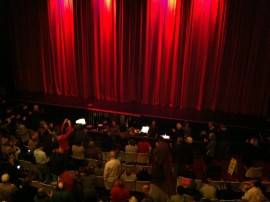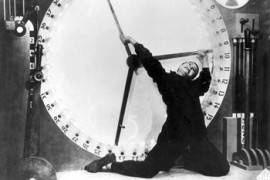I always feel like any trip to the Virginia to watch an old film is a special occasion and this experience was no exception. In what was dubbed “a silent movie event,” Metropolis kicked off Ebertfest with the accompaniment of the Alloy Orchestra.
Admittedly, when I read in the program ― just before the film started ― that the Alloy Orchestra is only a three-man musical ensemble, I got a little nervous and wondered if I’d later regret my decision to choose this particular film to review. The listing of instruments: junk percussion, accordion, banjo, musical saw, clarinet and synthesizer didn’t exactly tell me that this was going to be the full, rich orchestral sound experience I was seeking. I didn’t read their whole bio. though, and I couldn’t have been more wrong about what was about to unfold.
 I was two rows from the back of the theatre (thus, the mediocre picture) and couldn’t see them, but the three-man orchestra brought life to an old classic that was already receiving a boost from the extra 30 minutes of footage. Their new score got my pulse pounding when the workers marched, when danger ensued and when evil spread. It brought an added element of fear and excitement.
I was two rows from the back of the theatre (thus, the mediocre picture) and couldn’t see them, but the three-man orchestra brought life to an old classic that was already receiving a boost from the extra 30 minutes of footage. Their new score got my pulse pounding when the workers marched, when danger ensued and when evil spread. It brought an added element of fear and excitement.
This was the complete Metropolis that was found in Buenos Aires, Argentina back in 2008. Seems like an odd place to find a classic German film? Well, I thought the same thing. It turns out that silent films were shipped all over back then and they’d often get worn out during their tenure, never to return again. Also, German film apparently had a huge following in South America, so it made perfect sense that this film treasure popped up. It’s essentially what Fritz Lang created in 1927.
The new footage was on 16mm, easily distinguishable during viewing due to the darkness and scratches contained on the film. I think I liked it better that way because I really knew what had been missing before. I wasn’t searching for things to make it last any longer by any means (those old seats are really uncomfortable and there were a few select times that I found myself disinterested during the 150 minutes), but I could definitely see the film losing some meaning and clarity without those scenes. My discomfort and restlessness was probably only aided by the monotony of the machine workers’ day ― 10 hours of grueling labor surrounded by steam and trying to get those damn dial hands to move. It’s a great film but, let’s be honest, it’s still really long.
 It’s hard to say much about a film that’s been around and studied for over 80 years, but I will say that it looks great. I was amazed at the visuals of the city, which were highly influential in sci-fi films that would follow. Roger Ebert gives credit for the look of the mad scientist Rotwang, which he says was copied for years to come, notably in Bride of Frankenstein (1935). I hadn’t read this is the program until after the film but, strangely enough, I kept thinking the same thing about Brigitte Helm, who plays both good Maria and evil Maria, or “false Maria,” who’s actually a robot, and her likeness to Gene Wilder’s Dr. Frankenstein in Young Frankenstein (1974). The influences are extensive and there’s no point in me repeating Ebert’s findings. It makes a lot of sense though, and it’s a bit mind-blowing when you think about how many other great films borrowed from this one.
It’s hard to say much about a film that’s been around and studied for over 80 years, but I will say that it looks great. I was amazed at the visuals of the city, which were highly influential in sci-fi films that would follow. Roger Ebert gives credit for the look of the mad scientist Rotwang, which he says was copied for years to come, notably in Bride of Frankenstein (1935). I hadn’t read this is the program until after the film but, strangely enough, I kept thinking the same thing about Brigitte Helm, who plays both good Maria and evil Maria, or “false Maria,” who’s actually a robot, and her likeness to Gene Wilder’s Dr. Frankenstein in Young Frankenstein (1974). The influences are extensive and there’s no point in me repeating Ebert’s findings. It makes a lot of sense though, and it’s a bit mind-blowing when you think about how many other great films borrowed from this one.
My favorite scene of the film was after the transformation of Maria’s likeness onto the robot. The workers that Maria had led and cared for with her beacon of light were now roused and consumed with lust and fire during her scandalous dancing. The scene is fast-paced and swirling. Eyes are everywhere. The Alloy Orchestra played into a fast, pounding frenzy and I felt the music. I felt swept up in the chaos. I was spinning. I got lost in the eyes.
And, speaking of eyes, they were one of the most visually appealing elements of the film for me. Those silent movie eyes that are always outlined in dark mascara. All of the fear, mystery, wonder, and intrigue in Maria’s eyes, as well as Freder’s during his heroic adventure. I can only imagine that my eyes projected the same thing back as I stared into theirs and, for a couple of hours, I was trapped into seeing Metropolis through them: the clocks, the shadows and the evil that challenged the structure of the whole city itself.








